#23km
Text
Me, reading the time line today:

#interesting#very interesting#me and my big fancy prada bag#drove past all the posh shops on the bus today and was like#ohhh Hermes omarrrr oh ysl omaaarrr look it’s prada haha omaaarrr#just mimi things#I walked over 23km today my brain and bones are broken
4 notes
·
View notes
Text
its kind of astounding to me how i attend school full time and somehow also manage to ride an entire half marathon in the same day. its not even 5pm yet
#i got home and was like christ why am i so tired#like gee idk could be the 23km riding you did today + normal school + gruelling sewing college#i sat down to study for my math test tomorrow but oughhhhhhhhh#and despite it all im so out of shape. what a ripoff#thank god i’m unemployed!! cause remember when i had to ride 14km daily AND attend school and work for a total of a 13 hour day??
3 notes
·
View notes
Text
Of they make us run again im killing myse'f
3 notes
·
View notes
Text
Me gusta empezar las frases con "Me compré" sabiendo que soy desempleado y mantenido.
#me compré unas zapatillas ....... y las pagué con la tarjeta de mi vieja#me da vergüenza? claramente. pero no tengo horarios para un full time y facultad cuando capital me queda a 23km y la plata a 44km#se me dará en algun momento que se le va a hacer
5 notes
·
View notes
Text
blessed by the train gods, this is the second trip in a row without anyone next to me
4 notes
·
View notes
Text
Holy fuck an earthquake hit while I was on call with my friends right after DnD 😭😭😭
#ooc; the kaiju speaks#It was a tiny one so I'm fine but holy shit#I was in shock#Epicenter is only 23kms away too what the fuck
5 notes
·
View notes
Text
i learned today that cycling doesnt suck if you’re like not running late and just take it easy
1 note
·
View note
Text
One Tenth Scale Mata Nui

Mata Nui is a cool place, but did you ever feel that it was a bit...big for what it was?

The official maps put the island at 357 kio long, which if you take to be a stand in for kilometres¹, would make the island 357 kilometres long.


This lines up roughly with what we can see in the concept art: they say that Mata Nui is around the size of Denmark, the real measurement being 368km, and it matches with what we see in the Mata Nui Rising cgi video.
So that's all well and good, Mata Nui is 357km long, the GSR itself is 3300km tall, all hunky-dory, as long as you ignore some guy named Greggory yelling about how the robot is actually much bigger, but its fine to ignore him.
But now, actually consider what this means. Denmark is by no means a small country, it has a population of 6 million and would take hours to drive across by car on modern roads. Now that isn't an issue really, but in most media depicting the island its shown to be a place that can be traversed by foot or on animal back in a reasonable time frame.
But now let us look at this earlier map:
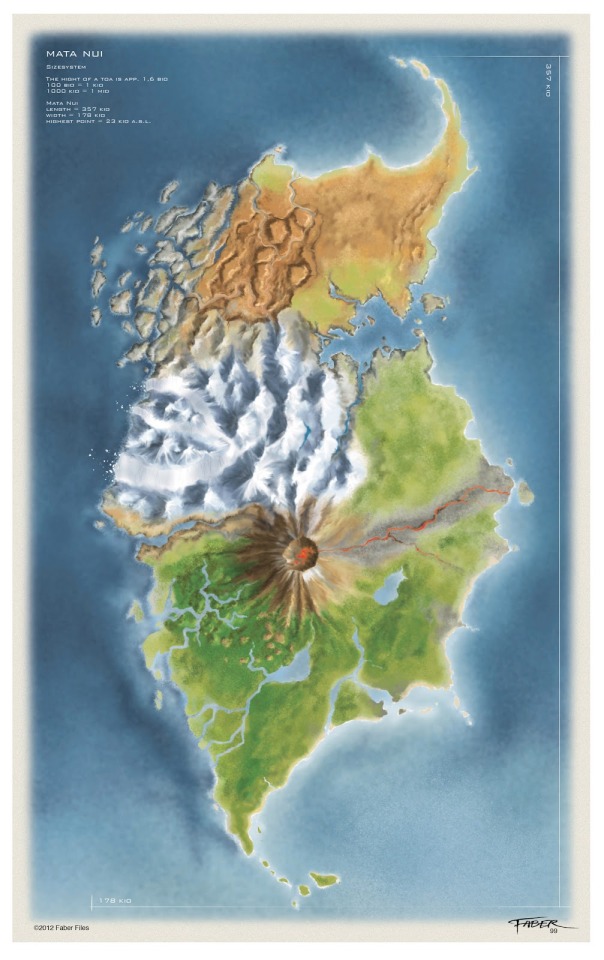
Initially the most interesting thing to me on this map was the 3rd measurement: the height of the Mangai volcano²

Now on the one hand, this was cool, now I know how tall to make the volcano, on the other hand... 23km seems pretty big.
It is. 23km is higher than Olympus Mons, the largest known volcano in the solar system, standing at only 21.9km. So that's pretty big. This made me start thinking about how far various things are apart and how long it would actually take and using some very VERY generous numbers I started plotting out how long it would take to actually get from place to place.
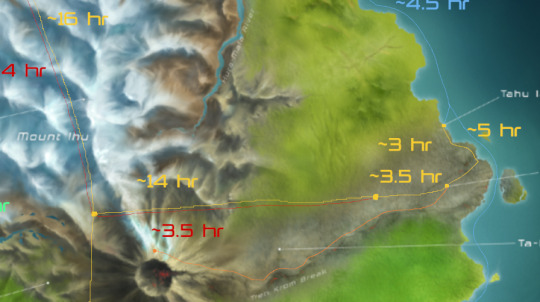
It wasn't very pretty. In the Mata Nui Online Game it would have taken Takua roughly 5 hours to walk from the beach to Ta-Koro, and another 18 to get to Onu-Koro using the highway. Now this would be fine in an epic like Lord of the Rings, but in Bionicle Mata Nui is consistently treated as a place people can pretty quickly get around on.
The Toa are running all over the place and bumping in to each other. Kopaka getting in to the Caldera at the top of the Mangai volcano isn't the equivalent of climbing 3 Mt Everests in a row, its just something he does [correction: It wasn't the caldera, but a lava pool half way up the mountain, so just 1.5 Mt Everests]. Takua travels all over the island in a pretty small amount of time, unless we're supposed to insert day long journeys in between every screen transition.
But then I noticed something. Something very interesting.
Now lets look at the two keys for the sizes on the released and the early map:


Seems pretty consistent, the sizes of the island are the same, a Toa is 1.6 bio on both (incidentally a real Toa figure is approximately 16cm tall), everything seems to match.
But then I counted the zeroes.
The old map has a kio being not 1000 bio, but 100!
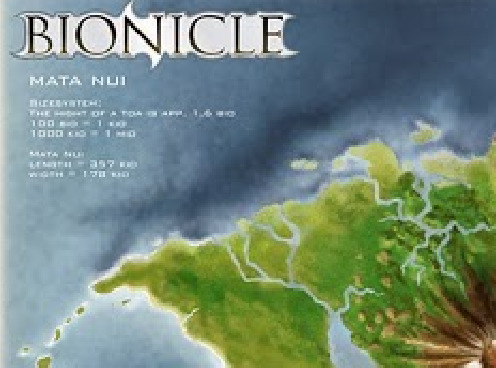
You can even see it on the other version of the map.
Now this is incredibly interesting! This shrinks Mata Nui to 1/10th of its commonly accepted size! It goes from being the size of Denmark to being the size of the Isle of Man.
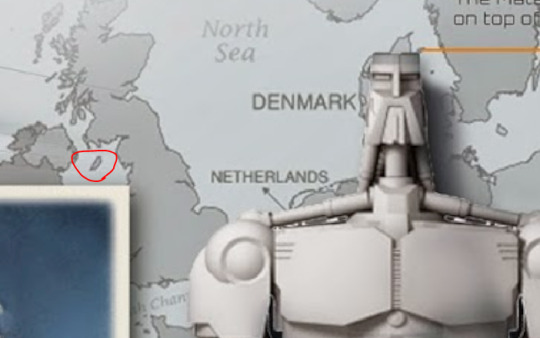
Which....really works a lot better! This turns Takua's trip from the beach from a 5 hour hike to a short half hour walk. This turns the cable car to Mt Ihu from a massive 70km mega structure to something that's dwarfed by real world constructions.
I don't think this is a mistake either, looking at the details of the map.


You have much finer details, such as these ice shelves collapsing in to small icebergs, whereas on the full sized map some of the larger chunks of ice are kilometres across.

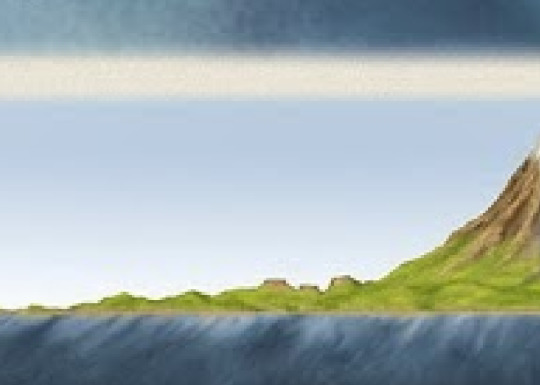
One of the major things it includes are the mesas that can bee seen in many of the promotional renders set in Le-Wahi which are nowhere to be seen on the final map. At this 1/10 scale the plateaus seen would match up well with the massive mesas seen in monument valley in terms of size, but with the final size they would be absolutely massive (10 times as big if you can believe it!)
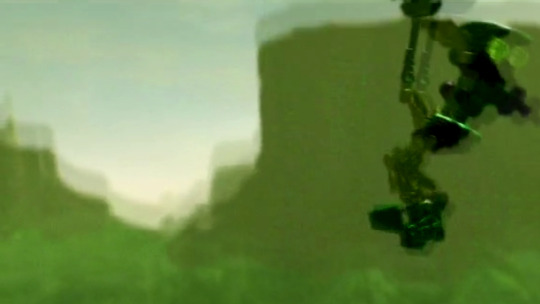

So suffice to say, I don't think this is just a case of a zero being dropped, it really seems to line up with the level of detail on this earlier map.
But what does this do to the GSR? I hear you cry, well it varies. Going by the earlier numbers it would simply be 1/10th the size, so 330km tall instead of 3300km, so still very large, but depending on the size relationship between the robot and the island it could be as "small" as 180km

The island in this picture is roughly the same size as normal, just covers more of the GSR. The final GSR's head is so proportionately tiny compared to its body that the Mata Nui island had to be very small to cover it. But in any case, a robot "only" 180km tall standing up is still going to tower over anything, its many times higher than airplanes fly, its taller than most clouds, really it would be quite consistent with this render:

So, in conclusion, an earlier concept of the island of Mata Nui has it being 1/10 of the size of the final, and that size seems to work better with what we see in various media from the time, and works better with the story.
Personally this is what I'll be going with in terms of the scale of the island going forward, as it really fits with my vision of the setting and works well with all the story and media from that time.
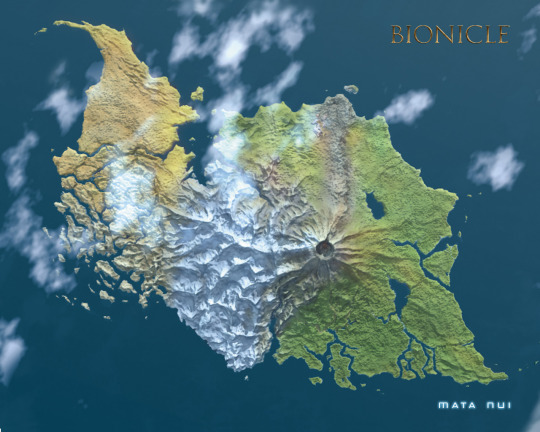
¹-I don't care about someone saying a bio is 4.375966487787¾ feet, feet aren't real and neither are you.
²-Mt Ihu is NOT the highest point on the island, the GSR isn't Pinocchio with a big pointy nose, this has never been reflected in any visual media.

thank you for reading/have a nice day
Update: I have made a companion post with many renders of George visiting places on the island to hopefully better illustrate the scale.
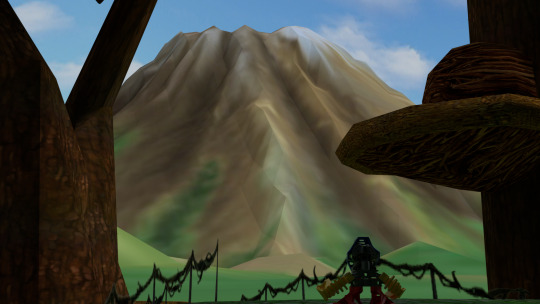
386 notes
·
View notes
Text

Between post-Covid malaise and buggering my knee, I've not been walking much these past few days.
Hoping to fix that tomorrow with a gentle 8km round-trip.
Too much reliance on the car - my usual 19-23km/l economy crashed to 15.6 on this tank.
Finished 3 sections of my "not a guide book" to Kobe.
11 notes
·
View notes
Text

Day fifteen on the Camino, 23km, total distance 181km
It's my longest remaining walk today. I have a faster pace than thus far, possibly because of walking together with FP. I'd told him "if luck allows we meet and I'm happy to walk together". I am happy I did and very content being alone this morning. FP is surely far ahead of me already.
It's another looong stretch of road-with-cars-to-duck. I march on an on and muse about nothing in particular it seems.
Rain! I can test my poncho over my bag! It works like a charm. Still sweaty inside though. If I decide to cut a corner to the campsite, I'm halfway done and it isn't even noon yet. I decide to cut the corner and have lunch next to a church.
When I'm almost done eating, a voice tells me "bonjour" and FP steps out of the church. He was hiding inside for the rain. I'm more happy to see him than I'd thought and we continue together.
FP has a good eye. Yesterday he spotted deer, and now he sees one again. She notices us in the distance, but remains grazing. We approach her silently, I stop using my hiking poles. She stays. We come closer. And closer. She even approaches us for a bit. And then it's too much and off she goes, prancing and bouncing through the fields of grain.
FP spots little prune trees, from which we eat. We talk about Paulo Coelhos book on the Camino, whih he's currently reading, about how to ask for more stamps in my pilgrims passport, and the things we've seen on the way from Vezelay to here. He explains to me that the field of white flowers on my left is in fact a field of coriander (!!!!!). I taste the leaves, it is true.
Because of our fast pace together, we arrive early at our destination and celebrate at a bar. This is where our Caminos split. I will pitch my tent at the "camping municipal". FP will continue for another 9km. In our shared English-French language, he tells me how happy he is we found each other again and that I "coached him through". I too am very grateful for this luck. We hug our goodbyes. "I apologize for smelling" "Yes me too". Bon courage, FP.
7 notes
·
View notes
Text

POV you are a piece of grass or perhaps an apple
rode 23km/14 miles
24 notes
·
View notes
Text
A light on a reef
Until the end of the 17th century one of the threats facing shipping heading to Plymouth on the southern coast of England was the isolated and treacherous Eddystone reef, 23km directly offshore. Much of the hazard is underwater, creating complex currents, and extraordinarily high seas are often kicked up when conditions are very windy. In 1620 Captain Christopher Jones, master of Mayflower described the reef: "Twenty-three rust red [...] ragged stones around which the sea constantly eddies, a great danger [...] for if any vessel makes too far to the south [...] she will be swept to her doom on these evil rocks." As trade with America increased during the 1600s a growing number of ships approaching the English Channel from the west were wrecked on the Eddystone reef.
King William III and Queen Mary were petitioned that something be done about marking the infamous hazard. Plan to erect a warning light by funding the project with a penny a ton charge on all vessels passing initially foundered. Then an enterprising character called Henry Winstanley stepped forward and took on the most adventurous marine construction job the world had ever seen. Work commenced on the mainly wooden structure in July 1696. England was again at war, and such was the importance of the project that the Admiralty provided a man-o-war for protection.

The Winstanley Lighthouse, by English School, 17th century (x)
On one day, however, HMS Terrible did not arrive and a passing French privateer seized Winstanley and carried him off to France. When Louis XIV heard of the incident he ordered his release. " France is at war with England, not humanity," said the King. Winstanley's was the first lighthouse to be built in the open sea. It was a true feat of human endeavour. Work could only be undertaken in summer and for the first two years nothing could be left on the rock or it would be swept away. There was some assistance from Terrible in transporting the building materials, but much had to be rowed out in an open four-oared boat in a journey that could take nine hours each way. Winstanley's lighthouse was swept away after less that five years, during the great storm of 1703.

John Rudyerd's wooden lighthouse of 1708, by Issac Sailmaker, c. 1708 (x)
Winstanley was in it at the time supervising some repairs- he had said that he wished to be there during " the greatest storm that ever was." The next lighthouse was built by John Rudyerd and lit in 1709. Also made largely of timber and with granite ballast, it gave good service for nearly half a century until destroyed by fire in 1755. During the blaze the lead cupola began to melt, and as the duty keeper, 94- old Henry Hall, was throwing water upwards from a bucket he accidentally swallowed 200g of the molten metal. No one believed his incredible tale, but when he died 12 days later doctors found a lump of lead in his stomach.
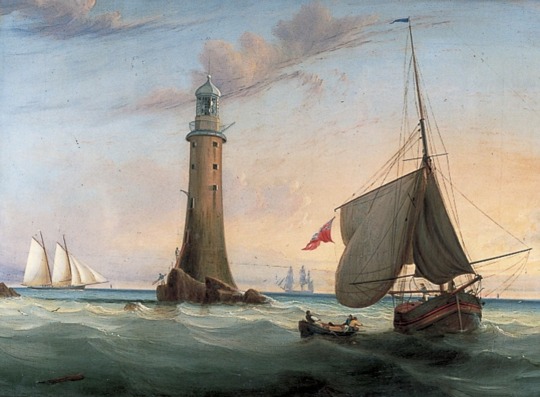
Smeaton's Eddystone Lighthouse, by John Lynn (active 1826-1869) (x)
John Smeaton, Britian's first great civil engineer, was the next to rise to the challenge of Eddystone. He took the English oak as his design inspiration - a broad base narrowing in a gentle curve. The 22m high lighthouse was built using solid discs of stone dovetailed together. Work began in 1756, and from start to finish the work took three years, nine weeks and three days. Small boats transported nearly 1000 tons of granite and Portland stone along with all the equipment and men.

Sir James N. Douglass's Eddystone Lighthouse, Plymouth, England, photochrome print, c. 1890–1900. The remnants of John Smeaton's lighthouse are at left. (x)
The Smeaton lighthouse stood for over 100 years. In the end it was not the lighthouse that failed; rather that the sea was found to have eaten away the rock beneath the structure. In 1882 it was dismantled and brought back to Plymouth, where it was re-erected stone on the Hoe as a memorial, and where it still stands.

The Eddystone lighthouse today (x)
It had already been replaced by a new lighthouse, twice as tall and four and a half times as large, designed by James Douglas, which now gives mariners a beacon of light visible for 22 nautical miles (40,78km).
80 notes
·
View notes
Text
plage de goulien/ cap de la chèvre










Plage de goulien/ cap de la chèvre
Ce matin, nous avions décidé de partir plus tôt...notre idée était d'arriver pas trop tard au camping ce soir pour profiter de la piscine...et en réalité hier soir, quand on a regardé le tracé du jour, on s'est dit qu'on avait pas le choix : 23km avec près de 700m de dénivelé!! ( qu est ce qu on a rit quand on a lu ça, beaucoup moins quand on l'a vécu...)
Aujourd'hui, nous ne croiserons pas de village, quelques achats au camping pour midi et on se met en route...well on est partit 30 minutes plutôt...( c est déjà ça !)
Changement et diversité des paysages...: beaucoup moins de bruyères, laissant place à des plaines d'oyats, puis des fougères à perte de vue...nous croiserons plusieurs plages de surfeurs où la baignade y est interdite.
12km après ( entre dénivelés et poids du sac, ça fait déjà 4h qu'on marche), le cap de la chèvre, l'extrémité sud de la presqu'île...pause déjeuner bien méritée à l'ombre du mémorial...
3 notes
·
View notes
Text
Another information about my HCD! au oc headcanons. Au rightfully belongs to @mylou-doodlesworld!
--------------------------------------------------
Appearance:

Dragon species name:
It is commonly known as: The Burning Flame.
But its actual species names are: The Toxic Scaleless Firewing, The Scaleless Venomwing or The Scaleless Firewing.
People call them these three names.
You will understand why later on.
Closely related to:
It is closely related to the Scaleless Sharpfin, which is also known as the Scaleless Fastfin.
It is believed that they are distant cousins.
What they can't do:
They can't fly as fast as their distant cousin.
They can't maneuver as well as their distant cousin in the air.
They can't adapt in new and foreign territories from other dragons.
They can't change colour.
They can't camouflage like their distant cousin.
They can't eat fish, as it makes them gag.
They are not agile.
What they can do:
They can swim well.
Can detect infrared heat from objects like a few snake species.
They can only eat human flesh.
They can hunt excellently.
They can breathe fire and ignite themselves on fire.
They can also coat their body in venom with the help of venom glands under their skin.
They can ignite themselves on fire and use the venom to create a toxic and deadly fire that can kill humans and dragons alike.
But it is VERY rare for them to do so!
They can lay up to two eggs.
The warm colours of their scaleless wings and tailfins produce heat.
Many say that it is like you were burning alive when you got near them.
They can fly 23km/h.
Unlike their distant cousin, they can track you from 4568 yards away.
Some differences:
They are the larger species between the two.
They can only eat human flesh.
They typically don't have horns.
They don't have retractable claws on their hands.
They make up for it by having retractable teeth.
Unlike their distant cousin, they have spines on their neck only.
Their wings are larger and more broad than their distant cousin.
They have larger ears made to hear the tiniest of movements.
Their sclera is a magenta colour.
Their irises are a deep green colour.
Tailfins are smaller and more jagged and sharp.
Highly venomous than their distant cousin.
It is believed that they have a protective instinct that activates when their distant cousin is in danger.
They don't sit on the eggs in order to incubate it.
Because the eggshell can easily break under any pressure.
It is also believed that they can sense their smaller distant cousin in danger.
Life expectancy:
There is not much information about these dragons.
But there was a specimen that was caught and was 1103 years old eight years ago.
It escaped and was spotted near the warmer areas a few times.
It is believed that they can roughly live between 1000 and 4000 years.
Dependency:
They are a solitary dragon species.
But when it comes to hunting, then they hunt in a group of 12.
Like pack animals.
It has been recorded that when their distant cousin is threatened or in dangered, they depend on the other group members to get rid of the threat.
Rarity and locations:
They can be found near warm forests or beaches.
There isn't really a correct estimation of how many there are.
But it is estimated that there are only 13 left in the whole world and Japan.
They mate for life.
These dragons are nearly extinct.
They have large muscular bodies built for combat.
Unlike their distant cousin, they have sharp talons which they use to dig.
They dig tunnels 30ft below the surface.
Extremely aggressive and will engage in combat when provoked or feel threatened.
Their eggs do have stripes, but they are not as colourful as their distant cousins' eggs.
They are intelligent enough to distinguish between powerful and weak dragons by using their sensitive detecting pits located on their nose.
This is the only known dragon species to have a crop like a bird.
Curious people found out that the crops of these dragon are just like a bird after finding a recently diseased male.
Can see infrared heat from objects with the help of heat pits under their eyes and jaws.
Eggs:
Unlike their distant cousin, they lay two eggs every two decades.
The eggs are very hard to find, as they are laid underground and out of danger.
Egg colour stripes and meaning:

Unlike the beautiful egg of their distant cousin, theirs are a bit plain with stripes.
The base colour of the egg is a dark maroon colour.
There are no other base colours for their eggs.
There are only two colours of the stripes on the eggs.
The stripes are yellow and orange.
The colours don't really have a meaning like the Scaleless Sharpfin/ Scaleless Fastfin's eggs.
If the yellow stripes are between the orange stripes, then it is a male.
The other way around is going to be a female dragon.
How to tell the infertile and fertile eggs apart:
It is really difficult to tell the fertile and infertile eggs apart.
But fertile eggs will give off a sweet smell.
Infertile eggs will give off the smell of that of a rotting corpse.
Males and females:
Unlike their cousins where you can tell the males and females apart by looking at their eye shapes and colours, females of this species are EXACTLY identical to the males.
Think of it as like the Mountain Goat, or known as the Rocky Mountain Goat.
But without knowing how to tell them apart.
Females and males are the same size, which makes it even more difficult to tell them apart.
What most people get wrong:
Most people think that if the dragon of this species is sitting and resting mistake them for a female.
Both males and females do this.
People mistake them for another dragon species that has been thought to be extinct.
Trust:
Their trust levels are zero towards humans.
However, when it comes to their distant cousin, they have a lot of trust.
Mating ritual:
No one has come out alive to tell how these highly aggressive dragons mate during mating season.
Except for one man named Yu Hinguru.
He said that this particular species don't do a dance or anything.
Yu explained how these dragons mate.
He explained that the males have to fight the females in order to successfully.
It is to prove that the male is capable of being a possible partner for the female.
If the male won, he would bite the female's neck and tear off a piece of flesh before licking the wound.
If the female won, she would kill the male and eat his body.
Just like a female spider eating her partner after mating.
Nesting:
Before nesting and laying eggs, the parents will eat a lot more than normal to built up fat.
They do this because they won't eat for 235 days.
After building the nest and laying the two eggs, then all hell breaks loose.
Both male and female will be even more aggressive than normal.
The females use their body temperatures to incubate the eggs.
The males will guard the entrance.
If the female didn't build up enough fat to last her 235 days, then the male will go hunt for her until she builds up enough fat to last during that time.
Their behaviour can be compared to Wild Dogs from Africa.
How they are during nesting season:
There are only three words to describe how they are during nesting season.
They are 10x more potective, aggressive and territorial than normal.
Personality and behaviour:
Aggressive.
These dragons know exactly how to show their behaviour and personality.
By showing aggression and killing anything that enters their territory.
Except their distant cousin.
Fun facts:
Did you know that they share some similar fun facts with their distant cousin?
Did you know that there are two species of this dragon?
( I was going to add another fun fact that is based on birds feeding their young, but thought that it would gross out many people and changed it. Should I add it? Let me know in the comments!)
#demon slayer#dragon species oc headcanons#angry oc with a hatred for humans#hantengu clones dragon au#dragon Hantengu clones au#HCD! au#DHC! au
14 notes
·
View notes
Text
19.09🩷
zjedzone: 578/600kcal
spalone: 1287kcal
waga: ??
kroki: 12k
rower: 23km
nawodnienie: 1,7l
Jestem dzisiaj mega zadowolona, ruszyłam się z domu i sporo ćwiczyłam 🙈.
Zrobiłam 20 przysiadów i 5 brzuszków, przeszłam 8km, a dodatkowo jeździłam na rowerze. 💪🏻
Byłam na spotkaniu z Miśkiem Kotarskim!🩷 Mam z nim zdjęcie i autograf:3
Co by tu jeszcze napisać... To raczej wszystko, bo dzisiaj nie mam jakichś większych przemyśleń 🫠.
Chudej nocki motylki!
#bede motylkiem#blogi motylkowe#motylki any#chce byc lekka jak motylek#lekka jak motyl#s3lf harn#bede lekka jak motylek#bede perfekcyjna#chudej nocy motylki#motylki blog
2 notes
·
View notes
Text
entahlah, ternyata kuliah sambil kerja tidak semudah itu, belum lagi PP 23km, mana tiap hari.
3 notes
·
View notes